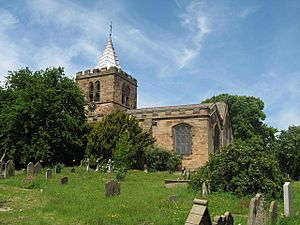St Deiniol's Church, Hawarden facts for kids
Quick facts for kids St Deiniol's Church, Hawarden |
|
|---|---|

St Deiniol's Church, Hawarden, from the southeast
|
|
| OS grid reference | SJ 315,659 |
| Location | Hawarden, Flintshire |
| Country | Wales |
| Denomination | Church in Wales |
| Churchmanship | Anglo-Catholic |
| Website | St Deiniol's Church Hawarden |
| History | |
| Status | Parish church |
| Dedication | St Deiniol |
| Architecture | |
| Functional status | Active |
| Heritage designation | Grade II* |
| Designated | 2 July 1962 |
| Architect(s) | James Harrison, Sir George Gilbert Scott, Douglas and Fordham, Douglas and Minshull |
| Architectural type | Church |
| Style | Gothic, Gothic Revival |
| Completed | 1909 |
| Administration | |
| Parish | Deeside Mission Area |
| Archdeaconry | Wrexham |
| Diocese | St Asaph |
| Province | Church in Wales |
St Deiniol's Church is located in the village of Hawarden, Flintshire, Wales. It is the main church for the area. This church is special because it has connections to William Ewart Gladstone, a famous former Prime Minister of the United Kingdom, and his family. The building is also recognized as a Grade II* listed building, which means it's a very important historical site.
Contents
A Look Inside St Deiniol's Church
Its Long History
The church's history goes back over 1,000 years! Records show rectors (church leaders) have been here since 1180. The church was fixed up by an architect named James Harrison around 1855–56.
However, on October 29, 1857, a fire badly damaged the church. Someone started the fire on purpose. Luckily, some parts like the stained glass and wooden areas at the east end were saved. The church was rebuilt by another famous architect, Sir George Gilbert Scott, and was ready by the end of 1859.
Later, more parts were added. In 1896, a porch was built by the architects Douglas & Fordham. This same company, later called Douglas & Minshull, designed the Gladstone Memorial Chapel between 1901 and 1903. They also added vestries (rooms for clergy) to the church in 1908–09.
What the Church Looks Like
Outside the Church
The church has a main area called the nave, with side sections called north and south aisles. It also has a chancel (the area around the altar) and several porches. The Gladstone Memorial Chapel is at the east end of the north aisle and has a rounded shape. The Whitley Chapel is at the east end of the south aisle.
The church has a tower in the middle, built in a style called Perpendicular Gothic. It has a short, pointed roof covered in lead. The church is not shaped like a cross (cruciform) because it doesn't have transepts (side arms).
Inside the Church
Inside the chancel, you'll find a sedilia, which is a set of seats for the clergy. It looks like it was restored in 1846 but might be much older. There's also a piscina, a basin used for washing sacred vessels. The font, where baptisms take place, was designed by Sir George Gilbert Scott.
The reredos, a decorated screen behind the altar, also seems to be designed by Scott. It shows a picture of the Last Supper. The choir stalls, where the choir sits, survived the fire and are from Harrison's restoration. A large cross called a rood was added in 1915–16 to remember William Glynne Charles Gladstone. The pulpit, where sermons are given, was designed around 1951.
Some wall paintings in the south aisle were made in 1884, but most of them have disappeared. The processional cross and special staffs carried by churchwardens were designed by George Frederick Bodley.
Special Memorials and Art
Many of the beautiful stained glass windows in the church are memorials to the Glynne and Gladstone families. Some windows from the 1850s were made by William Wailes. Other windows have glass designed by Edward Reginald Frampton, including one for his own wife.
The large west window was made in 1898 by Morris & Co. and was the last stained glass window designed by Edward Burne-Jones. It shows a scene of the Nativity (the birth of Jesus). The east window, also by Morris & Co. in 1907, reused another design by Burne-Jones. Other glass in the church was made by different artists.
The Gladstone Memorial Chapel holds a special monument for W. E. Gladstone and his wife Catherine. It was finished in 1906 and shows detailed sculptures of them lying down, with an angel above. The monument is made of different types of marble and bronze. The altar cross and candlesticks in the chapel were also designed by the same artist.
The oldest monument in the church dates back to 1722. There's also a monument for Sir Stephen Glynne, who passed away in 1874. It has a sculpture of him in a special alcove. Another memorial, made of alabaster and mosaic, remembers William Henry Gladstone. Other tablets remember different members of the Gladstone family.
You can also find a very detailed model of the church inside. It's a 1/48 scale model, built by local people over several years.
Outside the Church Grounds
In the churchyard, there's an old sundial and a memorial for the South African War from the early 1900s. The south gates to the churchyard were built in 1877. To the northwest, there's a lychgate (a covered gateway to a churchyard) designed in 1929.
The churchyard is also home to 57 Commonwealth war graves. These are graves for service members who died in wars, including 9 from World War I and 48 from World War II. One of the people buried here from World War I is William Glynne Charles Gladstone, a politician and grandson of the Prime Minister, who was killed in action in 1915.
More to Explore

